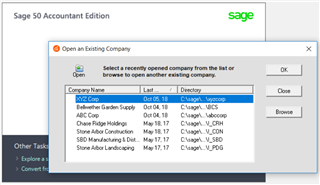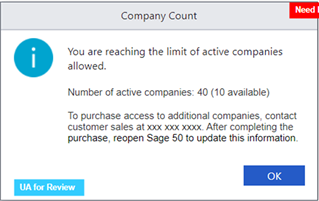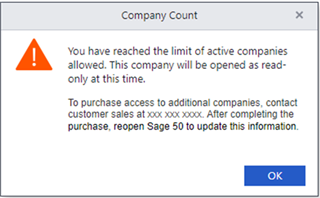The 2019.1 release of Sage 50 Accountant Edition delivers to you and your business several feature enhancements and improvements, with the helping accountants like you stay ahead of the curve, while providing the tools you need to offer better client service.
One of the most important changes users will be able to do within Sage 50 is the ability to set company files as Active or Inactive the first time they open each company file. Company files designated as Archived / Inactive will function the same as in the past with all the data viewable and with reports able to be run. However, new transactions on these archived companies cannot be added. These archived companies will not count against the 50 active client threshold.
What to Expect in the 2019.1 Release & How to Set Active / Inactive Company Files

This is the in-product messaging you will see when you first open your 2019.1 software.
 |
 |
The first time a company file is opened or created, accountants will be asked to designate it as active or inactive. You will always be able to see how many active company files you have already assigned, as well as how many you have left.
 |
 |
As you approach the 50 company limit, you will be reminded that you need to add companies over 50 and will be directed to your dedicated customer sales contact to assist you through the process.
Please Note:
- If you have 50 or less active clients, you may choose to clean up (delete and/or archive) old companies for which you no longer provide service. After the new release is loaded, you will begin designating which clients are “active” when you first open the company. If you no longer provide services for a company, but want to maintain the files, you can designate it as “inactive” when you open it. These companies will function the same as archived companies have in the past. You can view the data and product reports, but you cannot add new transactions or make adjustments. You can maintain an unlimited number of “inactive” companies.
- If you have 51 or more active clients, please contact Customer Sales to add licenses for any companies over the 50 client connection threshold so you can designate them as “active” upon open. The cost for the license will be prorated based on the date of your renewal. For example, if your renewal is six months from November, you will only be charged 50% of the additional company fee (starting at $20). When you receive your renewal, you will see an additional line item for these additional companies over the 50 billed at the full year rate.
Accountants are encouraged to set their active company files by November 30, 2018 to ensure active access to all their necessary company files, as well as an error-free billing process.
SAN Webcast: 11/01/2018
If you missed the U.S. Sage Accountants Network webcast session from November 1, 2018 -- please find the recorded session below.


Top Comments
-

GPhillips1
-
Cancel
-
Vote Up
0
Vote Down
-
-
Sign in to reply
-
More
-
Cancel
-

DonaldC
in reply to GPhillips1
-
Cancel
-
Vote Up
0
Vote Down
-
-
Sign in to reply
-
More
-
Cancel
-

campbellpacpa
in reply to DonaldC
-
Cancel
-
Vote Up
0
Vote Down
-
-
Sign in to reply
-
More
-
Cancel
Comment-

campbellpacpa
in reply to DonaldC
-
Cancel
-
Vote Up
0
Vote Down
-
-
Sign in to reply
-
More
-
Cancel
Children